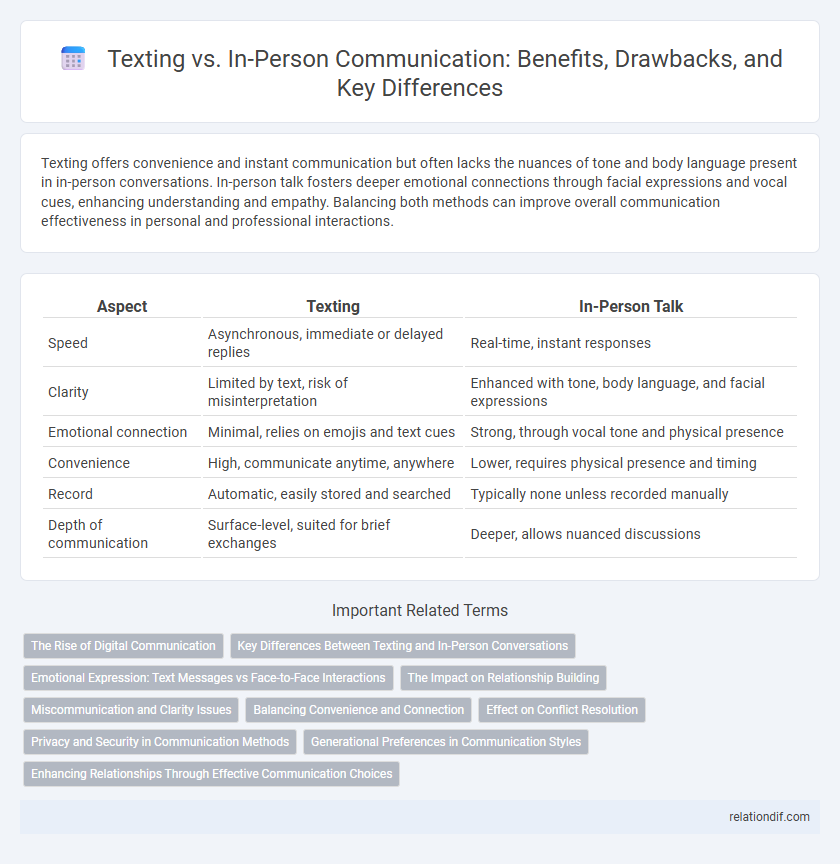Texting offers convenience and instant communication but often lacks the nuances of tone and body language present in in-person conversations. In-person talk fosters deeper emotional connections through facial expressions and vocal cues, enhancing understanding and empathy. Balancing both methods can improve overall communication effectiveness in personal and professional interactions.
Table of Comparison
| Aspect | Texting | In-Person Talk |
|---|---|---|
| Speed | Asynchronous, immediate or delayed replies | Real-time, instant responses |
| Clarity | Limited by text, risk of misinterpretation | Enhanced with tone, body language, and facial expressions |
| Emotional connection | Minimal, relies on emojis and text cues | Strong, through vocal tone and physical presence |
| Convenience | High, communicate anytime, anywhere | Lower, requires physical presence and timing |
| Record | Automatic, easily stored and searched | Typically none unless recorded manually |
| Depth of communication | Surface-level, suited for brief exchanges | Deeper, allows nuanced discussions |
The Rise of Digital Communication
The rise of digital communication has transformed how people interact, with texting becoming a dominant form of communication due to its convenience and immediacy. In-person talk offers richer emotional cues through body language and tone, which are often lost in text messages. Despite the efficiency of texting, the lack of nonverbal signals can sometimes lead to misunderstandings or reduced relational depth.
Key Differences Between Texting and In-Person Conversations
Texting allows rapid, asynchronous communication with the ability to carefully craft messages, while in-person conversations offer immediate feedback and richer emotional cues through body language and tone of voice. Non-verbal signals like facial expressions and gestures enhance understanding in face-to-face interactions, contrasting with the often ambiguous nature of written text. Furthermore, texting supports multitasking and convenience, whereas in-person dialogue fosters deeper connection and spontaneous problem-solving.
Emotional Expression: Text Messages vs Face-to-Face Interactions
Text messages often lack the nonverbal cues essential for conveying emotions, making it challenging to fully express feelings compared to face-to-face interactions. In-person conversations allow for tone of voice, facial expressions, and body language to enrich emotional communication, fostering deeper understanding and connection. Research shows that emotional clarity is significantly higher during face-to-face talks, reducing the risk of misunderstandings common in texting.
The Impact on Relationship Building
Texting facilitates quick exchanges but lacks nonverbal cues essential for emotional connection, often leading to misunderstandings in relationship building. In-person talk provides tone, facial expressions, and body language, strengthening trust and empathy between individuals. Studies indicate that face-to-face communication significantly enhances rapport and long-term relational satisfaction compared to digital messaging.
Miscommunication and Clarity Issues
Texting often leads to miscommunication due to the absence of vocal tone, facial expressions, and immediate feedback, which are crucial for clarity in conversations. In-person talk provides richer context through nonverbal cues, reducing ambiguity and enhancing understanding between participants. Studies show that misunderstandings occur 30% more frequently in text-based communication compared to face-to-face interactions.
Balancing Convenience and Connection
Texting offers unmatched convenience by enabling quick and asynchronous communication, making it ideal for managing busy schedules and staying connected across distances. In-person talk fosters deeper emotional bonds through nonverbal cues such as facial expressions, tone, and body language, essential for building trust and understanding. Balancing these modes requires recognizing when immediacy and clarity are paramount versus when meaningful connection benefits from face-to-face interaction.
Effect on Conflict Resolution
Texting often leads to misunderstandings in conflict resolution due to the absence of vocal tone and facial expressions, which are crucial for conveying emotions and intentions accurately. In-person communication facilitates immediate feedback and nonverbal cues like body language, enabling more effective de-escalation of disputes. Studies show that conflicts resolved face-to-face have higher satisfaction rates and longer-lasting resolutions compared to those handled through text messaging.
Privacy and Security in Communication Methods
Texting offers convenience but poses significant privacy risks due to potential data breaches, hacking, and message interception on unsecured networks. In-person communication provides a higher level of confidentiality, reducing exposure to digital surveillance and unauthorized access. Secure communication methods, such as end-to-end encrypted messaging apps, can mitigate risks but do not fully replicate the privacy inherent in face-to-face conversations.
Generational Preferences in Communication Styles
Younger generations often prefer texting for its convenience, speed, and the ability to multitask, while older generations tend to favor in-person conversations for deeper connection and clearer communication. Millennials and Gen Z prioritize digital communication platforms like SMS and instant messaging, reflecting their comfort with technology and preference for asynchronous interactions. Baby Boomers and Gen X typically value face-to-face talks for nuanced understanding and emotional cues that texting cannot fully convey.
Enhancing Relationships Through Effective Communication Choices
Texting offers convenience and instant connection but often lacks the emotional depth found in in-person conversations, which provide richer nonverbal cues and foster deeper understanding. Choosing face-to-face communication enhances empathy and trust, crucial for strengthening interpersonal relationships and resolving conflicts more effectively. Balancing texting with intentional in-person dialogue maximizes clarity and emotional engagement, promoting healthier and more resilient connections.
Texting vs In-person talk Infographic

 relationdif.com
relationdif.com